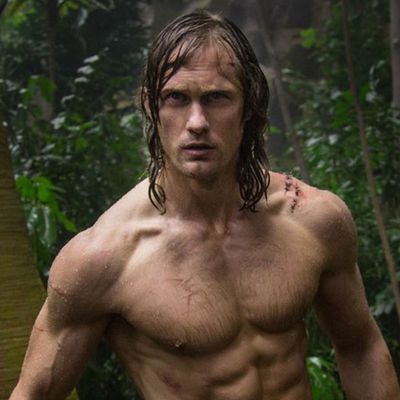
Why do filmmakers always louse up Tarzan? The 1914 Edgar Rice Burroughs book has a sensational first half, before the inevitable Victorian-EdwardianÔÇôera corniness and cultural supremacy kick in. Raised by apes, the child of shipwrecked English aristocrats doesnÔÇÖt turn out a dearie like Mowgli in The Jungle Book but a badass killer who swings soundlessly through trees and drops nooses on his foes (human and animal). He also finds his dead parentsÔÇÖ treehouse (still with their skeletons) and teaches himself to read (though he has no idea how the words actually sound ÔÇö or that the skeletons are his parents). The old Johnny Weissmuller pictures dumbed Tarzan down, but he and Maureen OÔÇÖSullivan looked scrumptious in their skimpy loincloths (at least before the Hayes Office came along and covered them up). Fifty years later, Robert Towne wrote a script that honored its source, but it was so mucked-up by English director Hugh Hudson that Towne gave the credit to his dog.
The new Tarzan film, The Legend of Tarzan, plays as if a dog ate part of the script. It opens with Alexander Skarsg├Ñrd as Tarzan ÔÇö n├®┬áJohn Clayton, Lord of Greystoke ÔÇö back in his baronial English manse, where heÔÇÖs ÔÇ£hybridizing coconuts,ÔÇØ with no intention of returning to the Belgian Congo. His splendid backstory, meanwhile, is sprinkled through the action in brief, hazy flashbacks, so the whole thing feels like a sequel to a movie that was never made. So damn frustrating!
Why does Clayton go back to Africa? It takes a lot of setup. If I followed it correctly, a tribal chief will hand over a load of diamonds that Belgium needs to finance its burgeoning slave trade in return for Tarzan, who committed some unspecified-until-later offense against him. ItÔÇÖs the job of the Belgian kingÔÇÖs nefarious envoy (Christoph Waltz) to lure Clayton back under false pretenses, and his unwitting accomplice in that task is George Washington Williams (Samuel L. Jackson), who comes to Clayton for help compiling evidence that the king is, indeed, enslaving the indigenous population. ClaytonÔÇÖs wife, Jane (Margot Robbie), insists on coming along because thatÔÇÖs what Jane does. SheÔÇÖs plucky that way.
Director David Yates did a yeoman job with the last few Harry Potter installments and made the fine British mini-series State of Play. (The American movie adaptation was negligible.) But either he has no interest in the African landscape or else the studio pared away the connective tissue, leaving nothing but formula dreck. The Legend of Tarzan feels as if it wants to be longer, to breathe a little and get down. The staging isnÔÇÖt inept, but individual shots seem truncated, the action pared down to its unoriginal essence. As it stands, the CG apes are impressive, the elephants (I donÔÇÖt know if theyÔÇÖre CG) magnificent, and a short scene in which a pair of lions nuzzle Clayton absolutely lovely. The humans could have used some help.
No, thatÔÇÖs not fair.┬áSkarsg├Ñrd could have made an excellent Clayton/Tarzan under different circumstances. He has the right combination of refined features and a rangy body that looks at home in the treetops. I donÔÇÖt think itÔÇÖs his fault that he canÔÇÖt get a rhythm going and ends up looking like a paler Viggo Mortensen. Among the movieÔÇÖs innumerable disappointments is that it takes an hour for him to remove his shirt (he never takes off his trousers), while Robbie is fully clothed from first to last. WouldnÔÇÖt those trousers constrict TarzanÔÇÖs vine-swinging? WouldnÔÇÖt Jane be more comfortable in a pair of jungle shorts? Sorry to be superficial, but you miss at least half the fun in a Tarzan movie without bare limbs.
Perhaps the thinking was that a half-naked Jane would be too predictably sexist. Oh, P.C., where is thy shame? And whoÔÇÖs kidding whom? Taken prisoner halfway through, Jane sassily asks the villain whether he expects her to ÔÇ£scream like a damsel.ÔÇØ A disarming line ÔÇö except the screenwriters are covering their asses. She stays tied up for most of the movie. The filmmakers do make sure to keep the materialÔÇÖs inherent racism in check. Individual Africans males are allowed to shine in action sequences, and Jackson is imperturbably Jackson ÔÇö modern, wisecracking, and anti-colonialist. His character has a backstory: He once stood by while Native Americans were slaughtered. He will not be so wimpish again. He will even get hold of a machine gun and blast his enemies to kingdom come. He will fight the power. That power includes the Church, at least implicitly. WaltzÔÇÖs hammy baddy swings a necklace with a crucifix on the end that turns out to be a most effective garrote. The Legend of Tarzan touches all the liberal bases, clumsily.
By the way, the onscreen title has a little ÔÇ£RÔÇØ next to it, denoting a trademark. ThatÔÇÖs very strange. IÔÇÖd figured that the character of Tarzan ÔÇö having first appeared in a 1912 short story ÔÇö was by now in the public domain. Did Warner Bros. execute a deft colonialist move and snatch it away from less-wealthy competitors? The Legend of Tarzan is unlikely to spawn imitators. This commercial vine is likely to snap, and The Jungle Book has the monkey-man franchise sewn up.


